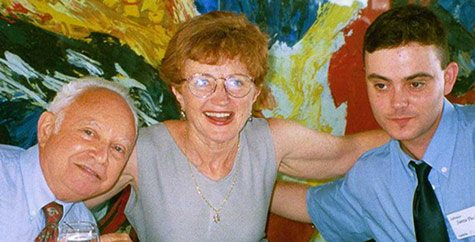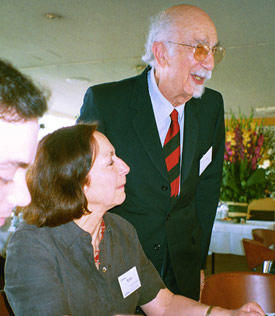A Conference on Ladino at UNESCO
by Rachel Amado Bortnick,
founder of Ladinokomunita, and co-founder of the Ladino Preservation Council of the
Foundation for the Advancement of Sephardic Studies and Culture.
What is being done the world over to preserve and promote Ladino (Judeo-Spanish)? What more should and can be done? These were the principal questions which were discussed on June 17-18, 2002, at the international conference on Ladino at UNESCO, in Paris, which brought together people from around the world who share the love and enthusiasm for Judeo-Spanish and work to keep it alive. The countries that participated and their delegates were: Argentina - Hélène Gutkowski; Bulgaria - Dora Mantcheva, Vladimir Paounovsky; England - Claudia Roden ; France - Jean Carasso, Marie Christine Varol, Isaac Papo, Gaëlle Collin; Germany - Michael Halevy, Winfried Busse; Greece- Erika Perahia Zemour; Israel - Moshe Shaul, Matilda Cohen-Sarano, Aldina Quintana, Aaron Cohen, Avner Pérez,; Italy: Esther Fintz-Menasce, Laura Minervini; Portugal - Monique Benveniste; Serbia (Yugoslavia) - Drita Tutunovic; Spain - Matilde Gini de Barnatan, Pilar Romeu, Salvador Santa Puche; Turkey - Yusuf Altintash, Klara Perahya, Beki Bardavid, and the musical group Los Pasharos Sefaradis. United States of America: Gloria Ascher, Rachel Amado Bortnick, David Siman. ( U.S.A. and Serbia are not UNESCO member nations.)

David Siman and Rachel Amado Bortnick of the United States
with Salvador Santa Puche of Spain
This first-ever Ladino conference at UNESCO (United Nations Educational Scientific and Cultural Organization), within the framework of the "United Nations Year of Cultural Heritage", was sponsored by Mr. Koïchiro Matsuura, Director General of UNESCO. Jean Carasso, editor of "La Lettre Sepharade" of France, and Moshe Shaul, vice-president of the National Authority for Ladino and its Culture in Israel, work long and hard, assisted by Mr. Yitshak Eldan, Israel's Ambassador at UNESCO, to organize this conference..
Sunday, June 16, a day before the opening, all the delegates met at the home of Ms. Arlette Burles to finalize the plans. And as always in Sephardic homes, Ms. Burles and her friends showed warm hospitality, and served us a rich array of typical Sephardic foods and desserts.
Several ambassadors from UNESCO member nations, as well as the representative of Director-General Matsura, were present at the opening session. Mr. Jean Carasso made the introductory comments, and Ambassadors Yitzhak Eldan of Israel and Francisco Villar of Spain, spoke, as did Professor Haim Vidal Sephiha, Holocaust survivor, who considered this conference as a symbol of a Jewish victory over the Nazi's evil plans of extermination.

Claudia Roden and Jean Carasso
Over 300 people filled the conference hall during the informational sessions and the following discussions, which treated the areas of instruction, transmission, conservation, creativity, and promotion of Ladino and the Sephardic cultural heritage of songs, folktales, poems, foods, etc. The present and potential role of the media, including the Internet, and the publication of newspapers, journals, and books in Ladino were also discussed. The delegates spoke on the activities in these realms in their respective countries. For example, Professor Gloria Ascher spoke on her Ladino courses at Tufts University, the only academic program of its kind in the United States; David Siman, spoke both about publications and about the informal courses in the United States; and I spoke on Ladinokomunita [1] , the Ladino-only correspondence group on the Internet. Presentations were made in French, Spanish, or Ladino, and the instantaneous translation was between French and Spanish only. Ms. Esther Fitz-Menasce of Milan presented a wonderful film, Rhodes Nostalgie (by Diane Perelsztejn, 1995) in memory of her deceased sister Vioetta Fintz.
A great amount of interesting information was presented, of which we note the following:
- Archives on the Jews of Salonica are preserved in microfilm at the Holocaust Museum of Washington.
- Maale Adumim in Israel has archived thousands of old Ladino texts, in all scripts and types, and is seeking more. [2]
- A Center for Sephardic Studies is being created at the University of Murcia, Spain.
- With the initiative of the National Authority of Ladino, certification courses are offered for teachers of Ladino, with an enrollment of 30-40 per year.
- Ladinokomunita has over 500 members, including many young people who are studying, or are interested in Ladino.
- An Internet chat room called "Salon de Moabet", where people can speak with each other in Ladino, was initiated by the Ladino Preservation Council (LPC) of the Foundation for the Advancement of Sephardic Studies and Culture (FASSAC). [3]
- Today, 20 % of the Jews of Greece (5% of those in Athens) speak or understand Ladino. In Sarajevo, Bosnia, only 5 people remain who speak the language. In Istanbul (according to Klara Perahya's survey) 31 % of young people aged 10-21 speak or understand to some degree, and many want to learn the language
At the end of the meetings, Moshe Shaul presented the list of resolutions taken for the continuation and intensification of the efforts to maintain the Sephardic language and culture.
Mr. Jean Carrasso showed generous hospitality to all the delegates, and UNESCO's Turkish Ambassador Bozkurt Aran honored all Turkish and Turkish-born delegates with an elegant dinner at his home on the evening of June 17.
The conclusion of the conference was celebrated with a wonderful concert by "Los Pasharos Sefaradis" of Istanbul at the Alliance Francaise of Paris. Ambassador Aran was in the audience.
These events were followed on June 19 with the "Fiesta de Djoha"at the large hall of Cartoucherie de Vincennes, organized by the "Association Aki Estamos" and "Les Amis de la Lettre Sépharade" of Paris. Here, too, there was Sephardic music, songs, folktales for adults and children, as well as Sephardic food and book sales. This day concluded with comedy sketches featuring Matilda Koen Sarano and Leon Sasson. That same evening Professor Haïm Vidal Sephiha gave a lecture on the Ladino Bibles in the Jewish Museum of Paris, to which he contributed a facsimile of the famous Ferrara Bible (1553.)
This international Sephardic gathering and conference in Paris allowed us to meet old friends and make new ones, and it has given us renewed enthusiasm for our language and culture. As Moshe Shaul declared: "Above all, this conference represents the recognition by UNESCO that Ladino and its traditions are important and must be preserved. We hope that UNESCO will give us financial support, but until that happens, at least we will have its moral support."
__________________________
1. www.sephardicstudies.org/komunita/html
2. contact Avner Perez at: maaleadum@barak-online.net
3. LPC, founded by Rachel Bortnick, David Siman and Bob Bedford, is a function of FASSAC. For information write: info@sephardicstudies.org
© 2002 Rachel Amado Bortnick, Foundation for the Advancement of Sephardic Studies and Culture, NY


Nenhum comentário:
Postar um comentário